“The future belongs to those who understand the power of technology to transform industries,” said Dr. Jagreet Kaur Gill, a pioneer in modern transportation systems. This quote encapsulates the essence of how advanced solutions are reshaping the way businesses manage their operations. The integration of real-time data and predictive analytics has become a cornerstone of innovation in this field.
Historically, transportation has evolved from manual processes to highly automated systems. Today, the focus is on enhancing operational efficiency and reducing costs. Companies that adopt these technologies can achieve significant improvements in their supply chain management, leading to better customer satisfaction and streamlined processes1.
This article explores how these advancements are driving change, offering insights into practical implementations and their benefits. From route optimization to demand forecasting, the possibilities are endless. Stay tuned to discover how these innovations are shaping the future of transportation.
Key Takeaways
- Real-time data and predictive analytics are transforming transportation systems.
- Advanced technologies improve supply chain efficiency and reduce costs.
- Historical insights from experts like Dr. Jagreet Kaur Gill provide valuable context.
- Route optimization and demand forecasting are key areas of innovation.
- These advancements lead to better customer satisfaction and streamlined operations.
Introduction to AI Agents in Transportation

The transportation sector is undergoing a transformative shift, driven by advanced technological solutions. These innovations are redefining how businesses manage their supply chain and improve operational efficiency. By leveraging real-time data and automation, companies can enhance service delivery and reduce costs2.
Smart systems are designed to address inefficiencies in traditional processes. For example, they can optimize inventory levels, reducing waste and operational expenses2. This not only improves resource allocation but also ensures better customer satisfaction. The integration of these tools into legacy systems, however, remains a significant challenge3.
One of the key benefits of these solutions is their ability to analyze vast datasets. This allows businesses to predict disruptions and make proactive decisions2. For instance, companies like UPS have implemented systems that reduce driving miles and fuel consumption, showcasing the potential of these technologies3.
As the industry evolves, the focus is on creating predictive and adaptive models. These innovations are expected to enhance resilience and streamline operations. Future trends indicate that these systems will handle complex tasks with minimal human intervention, further transforming the sector2.
In the following sections, we will explore how these advancements are shaping the future of transportation. From route optimization to demand forecasting, the possibilities are endless. Stay tuned to discover how these innovations are driving change across the industry.
Evolution of Transportation Technology and the Role of AI

From the steam engine to autonomous vehicles, technology has reshaped how goods and people move. Each innovation has brought new levels of efficiency and cost savings, transforming industries and societies4.
In the 19th century, the steam engine revolutionized travel and trade. It enabled faster movement of goods, reducing costs and expanding markets4. This marked the beginning of modern transportation systems.
Today, the focus is on automation and data-driven solutions. Autonomous vehicles, for example, can reduce transportation costs by 10% to 20% compared to traditional methods4. These advancements are reshaping supply chain management and improving operational efficiency.
Businesses now rely on real-time data to make informed decisions. AI-driven systems analyze traffic patterns and weather conditions, optimizing routes and reducing fuel consumption5. This integration of technology ensures smoother operations and better customer satisfaction.
The future of transportation lies in predictive models and smart systems. Companies that adopt these innovations can achieve significant improvements in their supply chain, leading to cost savings and enhanced performance4.
Understanding “AI Agents in Transportation: Streamlining Logistics and Delivery”
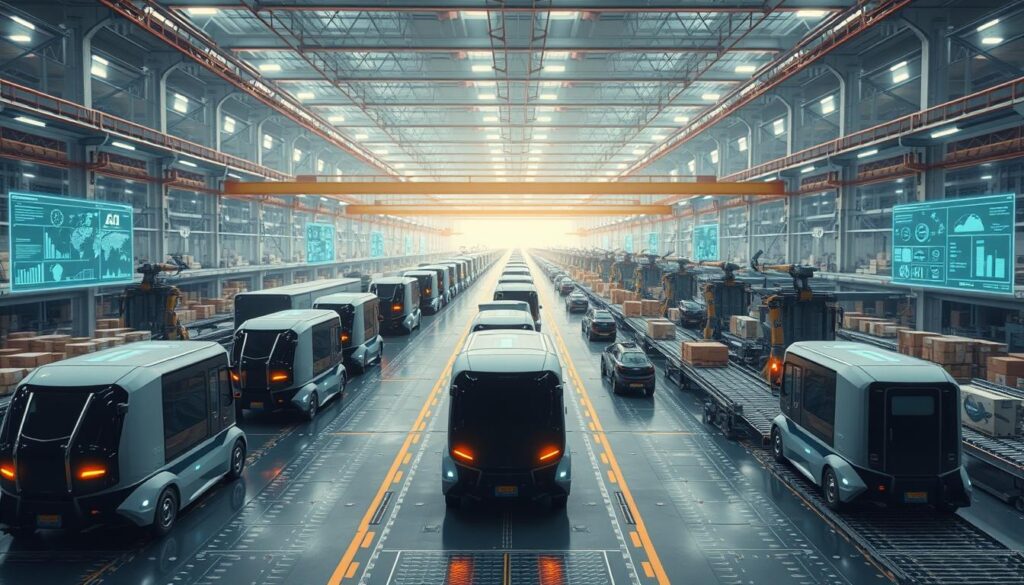
The integration of advanced systems into transportation networks is revolutionizing how businesses operate. These tools are designed to enhance operational efficiency and reduce costs, making them essential for modern supply chain management6.
One of the key benefits of these systems is their ability to analyze vast datasets. This allows companies to predict disruptions and make proactive decisions. For example, businesses using predictive analytics have reduced fuel consumption by up to 18%6.
Effective integration of these tools into existing processes can significantly improve performance. Companies like DHL have achieved a 15% increase in operational efficiency through data-driven solutions7. This highlights the strategic value of adopting innovative technologies.
Challenges remain, particularly in ensuring seamless system integration. However, the benefits far outweigh the obstacles. Businesses that embrace these solutions can achieve cost reductions of up to 30%6.
As the industry evolves, the focus is on creating predictive and adaptive models. These innovations are expected to enhance resilience and streamline operations. Future trends indicate that these systems will handle complex tasks with minimal human intervention, further transforming the sector6.
In summary, the adoption of advanced systems is reshaping the transportation and logistics landscape. By leveraging predictive analytics and real-time data, companies can improve efficiency, reduce costs, and meet growing market demands7.
The Need for Agentic AI in Modern Transportation
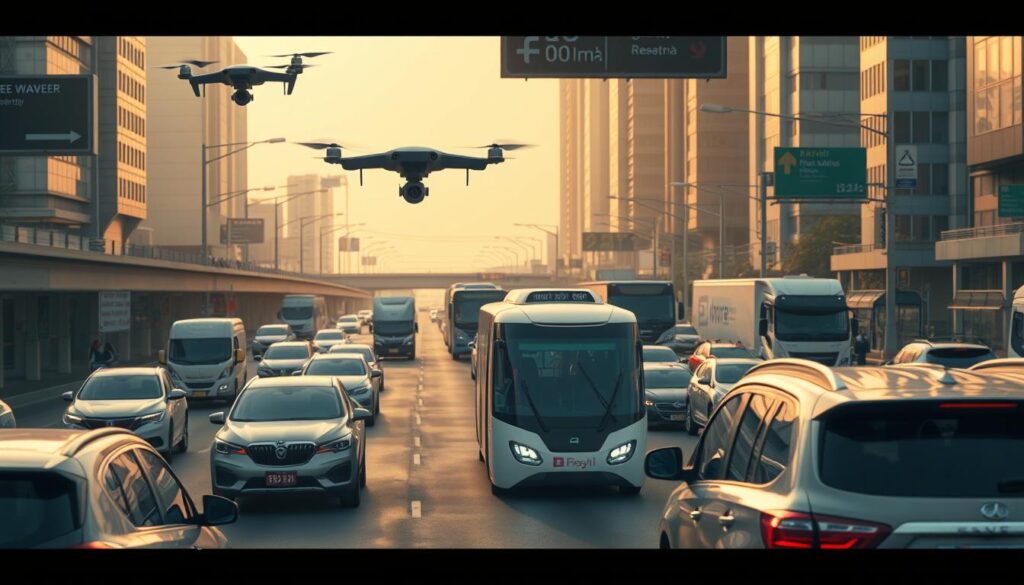
Modern transportation faces unprecedented challenges, demanding innovative solutions. Rising demand and cost concerns are putting immense pressure on the industry. Traditional systems are struggling to keep up, leading to inefficiencies and delays8.
One major issue is coordination inefficiency. Outdated processes often result in wasted resources and increased operational costs. Environmental impacts are another concern, as traditional methods contribute to higher carbon emissions9.
Advanced systems offer a way forward. By automating processes, these solutions reduce costs and improve efficiency. For example, predictive analytics can lower delay-related costs by up to 25% by 20258. This not only saves money but also enhances customer satisfaction.
Effective management and technology integration are crucial. Companies that adopt these innovations can achieve significant improvements in their supply chain. Real-time data from IoT sensors, for instance, provides critical updates on vehicle status and traffic conditions8.
Case studies highlight the benefits. Businesses using predictive systems have seen a 30% productivity boost in shipment tracking8. These advancements are reshaping the industry, making it more resilient and efficient.
Adopting advanced solutions is essential for future competitiveness. As the sector evolves, companies must embrace innovation to stay ahead. For more insights, explore how smart systems are transforming transportation.
Transforming Supply Chain and Logistics with AI
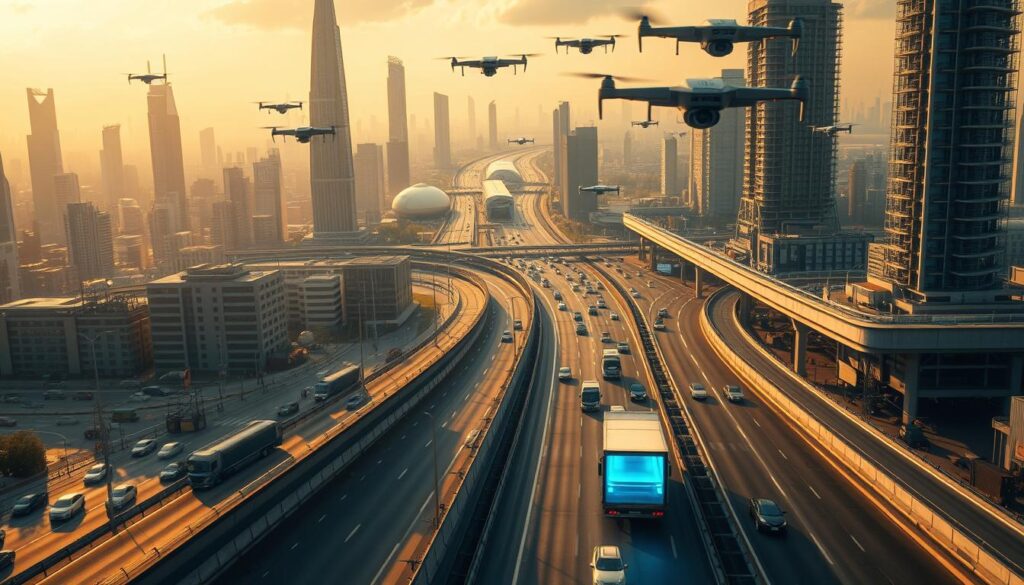
The future of supply chain management is being reshaped by innovative technologies. Companies are leveraging advanced systems to enhance operational efficiency and streamline processes. By integrating real-time data, businesses can make informed decisions, reducing costs and improving performance10.
One of the key benefits of these solutions is their ability to optimize communication between various nodes. For example, predictive analytics can forecast demand accurately, reducing stockouts and improving inventory management10. This ensures smoother operations and better resource allocation.
Automated systems are also transforming tracking and maintenance processes. Predictive maintenance reduces downtime and extends the lifespan of machinery, leading to significant cost savings10. Dynamic route optimization further minimizes fuel consumption, contributing to sustainability goals11.
Leading companies like Amazon and FedEx have implemented these technologies with measurable success. FedEx, for instance, uses advanced algorithms to reduce empty miles, improving efficiency and reducing environmental impact11. Similarly, Amazon’s automated systems have enhanced delivery speed and customer satisfaction.
Effective integration of these tools into existing processes is crucial. Businesses that adopt these innovations can achieve up to 30% cost reductions while improving customer service10. This highlights the strategic value of embracing technological advancements.
In summary, the adoption of advanced systems is revolutionizing the supply chain and logistics landscape. By leveraging predictive analytics and real-time data, companies can enhance efficiency, reduce costs, and meet growing market demands. For more insights, explore how smart systems are transforming transportation.
Enhancing Operational Efficiency and Reducing Costs

Businesses are leveraging advanced systems to streamline their operations and cut costs. These tools enhance operational efficiency by automating repetitive tasks and optimizing resource allocation. For example, companies using predictive analytics have reduced delivery times by 25%12.
Dynamic scheduling and predictive maintenance are key to cost reduction. By analyzing equipment data, businesses can minimize downtime and extend machinery lifespan. This approach has led to a 35% reduction in manual labor costs12.
Route optimization is another critical factor. Advanced systems analyze traffic patterns and fuel use, reducing consumption by 10-15%13. This not only lowers expenses but also supports sustainability goals.
Case studies from industry leaders highlight tangible benefits. DHL, for instance, achieved a 15% increase in operational efficiency through data-driven solutions13. Similarly, Walmart has optimized its supply chain, reducing inventory holding costs by 30%12.
Real-time analytics play a crucial role in identifying inefficiencies. Companies can make informed decisions, improving delivery times by 20%13. This ensures better customer satisfaction and streamlined processes.
Improved performance translates into greater market competitiveness. Businesses adopting these innovations often achieve full cost recovery within the first year12. As the industry evolves, companies must embrace these solutions to stay ahead.
Real-Time Data Integration and Predictive Analytics
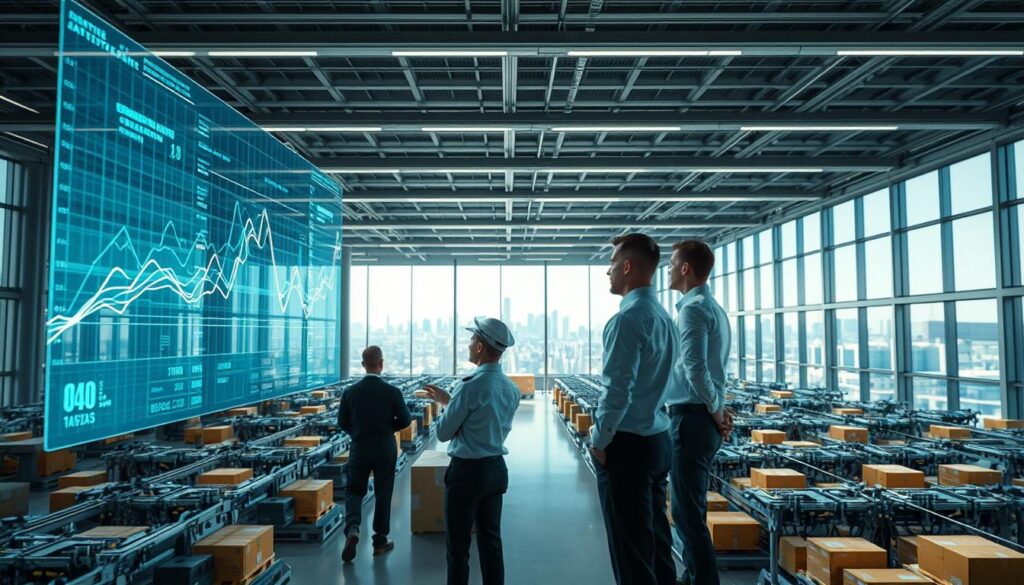
The ability to harness real-time information is reshaping how businesses manage their operations. By integrating live updates from sensors, GPS, and IoT devices, companies can make smarter decisions. This approach enhances operational efficiency and reduces costs, making it essential for modern supply chain management14.
Data Collection and Integration Techniques
Collecting and processing live updates requires advanced technology. Sensors and IoT devices gather information every 30 seconds, providing critical insights into vehicle location and conditions14. This data is then integrated into systems that analyze patterns and predict disruptions.
For example, GPS trackers and environmental sensors monitor parameters like temperature and humidity. This ensures quality control during transit, reducing risks and improving customer satisfaction15.
Machine Learning and Continuous Improvement
Machine learning models play a key role in processing historical and live data. These models identify trends and optimize routes, reducing fuel consumption by up to 15%14. Continuous improvement is achieved through feedback loops, ensuring systems adapt to changing conditions.
Companies like FedEx use predictive analytics to enhance delivery timelines. This not only improves efficiency but also boosts customer trust15.
In summary, integrating real-time data and predictive analytics is transforming the industry. Businesses that adopt these solutions can achieve significant cost savings and improved performance.
Intelligent Decision-Making: Autonomous Routing and Scheduling
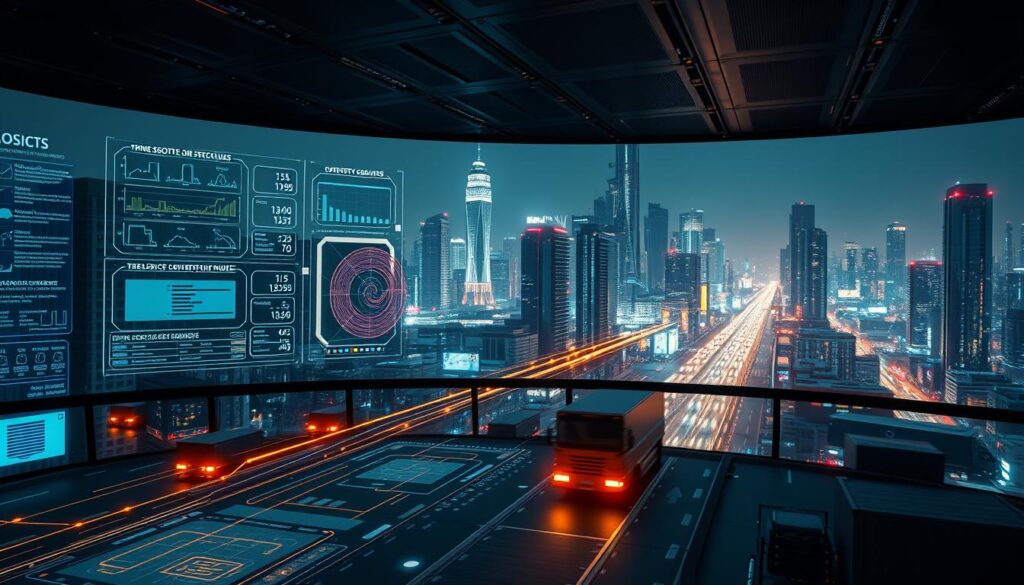
The future of logistics hinges on intelligent systems that adapt to real-time changes. These solutions are transforming how businesses manage their supply chain, ensuring smoother operations and better customer satisfaction. By leveraging advanced technology, companies can reduce costs and improve efficiency.
Dynamic Route Optimization
Dynamic route optimization uses real-time data to adjust paths based on traffic, weather, and other factors. This approach minimizes travel distances, reducing fuel consumption by up to 15%16. Companies like UPS have implemented these systems, achieving significant cost savings and faster delivery times17.
Advanced algorithms analyze traffic patterns and road conditions, ensuring optimal routes. This not only improves performance but also supports sustainability goals. For example, FedEx uses predictive analytics to enhance delivery timelines, boosting customer trust17.
Automated Scheduling Strategies
Automated scheduling balances supply and demand by adapting to real-time changes. These systems reduce wait times and improve user experience, especially during peak seasons18. For instance, DHL has achieved a 15% increase in operational efficiency through data-driven solutions17.
Predictive maintenance ensures timely servicing, reducing vehicle downtime by up to 30%18. This approach extends machinery lifespan and lowers maintenance costs. As the industry evolves, these innovations will handle complex tasks with minimal human intervention.
In summary, intelligent decision-making is reshaping logistics. By integrating real-time data and predictive analytics, businesses can achieve significant cost reductions and improved performance. The future lies in adaptive systems that enhance efficiency and meet growing market demands.
Improving Safety and Customer Experience in Transportation
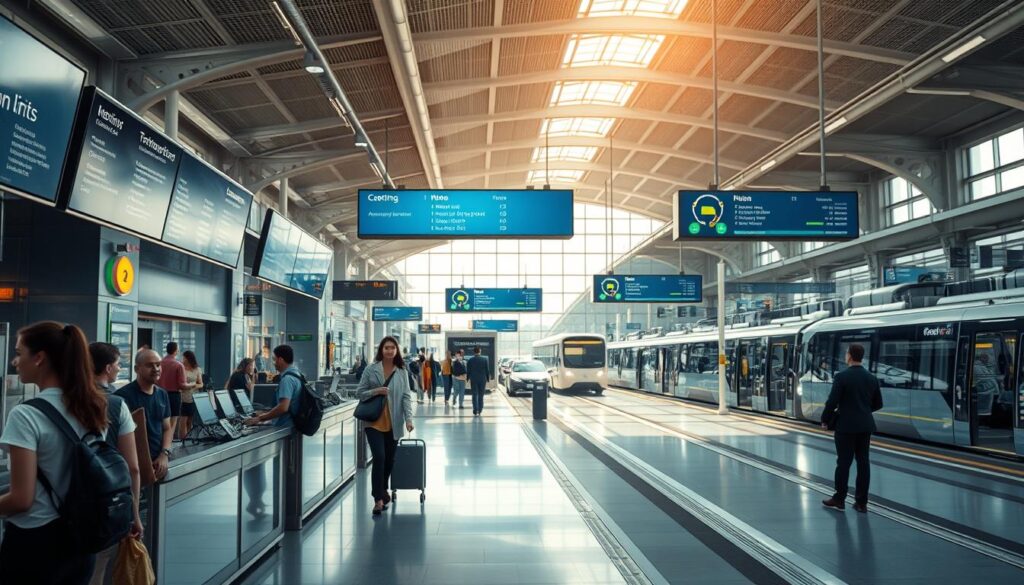
Safety and customer satisfaction are becoming top priorities in modern transportation systems. Companies are adopting innovative solutions to address these needs, ensuring smoother operations and better outcomes. From advanced driver monitoring to real-time customer support, these advancements are reshaping the industry.
Driver Safety Monitoring Systems
Advanced driver safety monitoring systems are reducing accidents and improving road safety. These systems use sensors and real-time data to monitor driver behavior, providing alerts for potential risks. For example, predictive analytics can forecast potential failures, allowing for timely maintenance and reducing unexpected breakdowns19.
Continuous feedback from vehicle sensors ensures drivers stay alert and focused. This technology has led to a significant reduction in unsafe driving behaviors, enhancing overall safety20. Proactive monitoring also lowers insurance and maintenance costs, benefiting both companies and drivers.
Enhanced Customer Support Solutions
Customer service in transportation has seen remarkable improvements with the integration of advanced solutions. Real-time tracking and virtual assistants provide seamless communication, ensuring customers stay informed about their deliveries. For instance, AI-powered chatbots handle inquiries around the clock, improving response times and satisfaction20.
Transportation companies are leveraging these tools to enhance delivery accuracy and reduce delays. By optimizing routes and minimizing disruptions, businesses can meet customer expectations more effectively19. This approach not only improves service quality but also builds trust and loyalty.
Looking ahead, further advancements in safety and customer support are expected. These innovations will continue to drive efficiency and satisfaction, making transportation systems more reliable and user-friendly.
Expanding Applications of AI Across Transportation Operations

The transportation industry is witnessing a paradigm shift, driven by cutting-edge solutions that redefine operational strategies. These innovations are transforming how businesses manage their supply chain, optimize resources, and meet growing market demands. From freight load optimization to smart parking systems, the applications are vast and impactful.
Freight Load Optimization and Fleet Management
One of the most significant advancements is in freight load optimization. By analyzing real-time data, companies can maximize vehicle usage and reduce fuel consumption. This approach not only lowers costs but also minimizes environmental impact21.
Autonomous fleet management solutions are also gaining traction. These systems improve scheduling and reduce overheads, ensuring smoother operations. For example, predictive maintenance can cut vehicle downtime by up to 30%, enhancing both efficiency and safety22.
Public Transport Forecasting and Smart Parking
Public transport systems are benefiting from advanced forecasting methods. By leveraging historical and real-time data, operators can predict demand and allocate resources effectively. This ensures better service quality and higher customer satisfaction21.
Smart parking systems are another innovative application. These solutions optimize parking spaces, reducing urban congestion and improving traffic flow. For instance, real-time monitoring can guide drivers to available spots, saving time and reducing emissions21.
As the industry evolves, these advancements will continue to drive innovation and improve operational performance. The future of transportation lies in the seamless integration of these technologies, creating a more efficient and sustainable system.
Transforming Urban Mobility and Public Transit with AI

Cities are evolving rapidly, and advanced systems are reshaping how people move within urban spaces. These innovations are addressing challenges like traffic congestion and inefficiencies in public transit. By leveraging real-time data, cities can optimize their supply chain and improve management of resources23.
Smart traffic management systems are at the forefront of this transformation. They use real-time data to adjust traffic signals, reducing congestion and improving flow24. This not only saves time but also lowers emissions, contributing to a greener environment.
Predictive analytics play a crucial role in forecasting transit demand. By analyzing patterns, cities can allocate resources more effectively, ensuring smoother operations23. For example, predictive models can optimize bus schedules, reducing wait times and enhancing customer satisfaction.
Public transport scheduling has also seen significant improvements. Advanced systems integrate with smart infrastructure, enabling real-time updates and better route planning25. This ensures that services are more reliable and efficient, meeting the needs of growing urban populations.
Several cities have already benefited from these advancements. For instance, Arriva UK Trains uses generative systems to enhance customer interactions, streamlining processes and improving service delivery23. Similarly, smart parking solutions in urban areas reduce idle times, ensuring quicker access for delivery vehicles24.
The environmental benefits of these systems are undeniable. By reducing emissions and optimizing energy usage, cities can achieve sustainability goals25. This not only improves air quality but also supports long-term urban planning efforts.
Looking ahead, the integration of these technologies will continue to drive innovation in urban mobility. As cities grow, the need for efficient and sustainable solutions becomes even more critical. The future of urban planning lies in harnessing the power of advanced systems to create smarter, greener cities.
Integrating AI with Existing Transportation Systems

Seamlessly blending advanced technologies with traditional systems is the cornerstone of modern transportation evolution. Companies are increasingly focusing on integration to enhance their supply chain and improve overall management. This process ensures smoother operations and better customer satisfaction.
Developing a Robust Data Infrastructure
Modernizing data infrastructure is essential for supporting advanced solutions. A strong foundation allows businesses to process real-time data efficiently, enabling better decision-making. For example, companies that invest in robust systems report a 25% increase in operational efficiency within the first year26.
Interoperability between legacy systems and new technologies is critical. This ensures seamless integration without disrupting ongoing operations. Businesses that prioritize this approach often achieve significant cost savings and improved performance.
Effective System Integration Strategies
Minimizing downtime during integration is a top priority. Strategies like phased implementation and continuous monitoring help reduce disruptions. For instance, predictive analytics can forecast potential issues, allowing for timely adjustments27.
Ensuring data quality and security is equally important. Companies must adopt best practices to protect sensitive information while maintaining accuracy. This not only enhances efficiency but also builds trust with customers.
Real-world examples highlight the benefits of successful integration. Organizations that overhaul their data processing systems often see a 15% reduction in delivery times26. These improvements translate into long-term benefits for overall management and customer satisfaction.
Emerging Trends in AI for Transportation
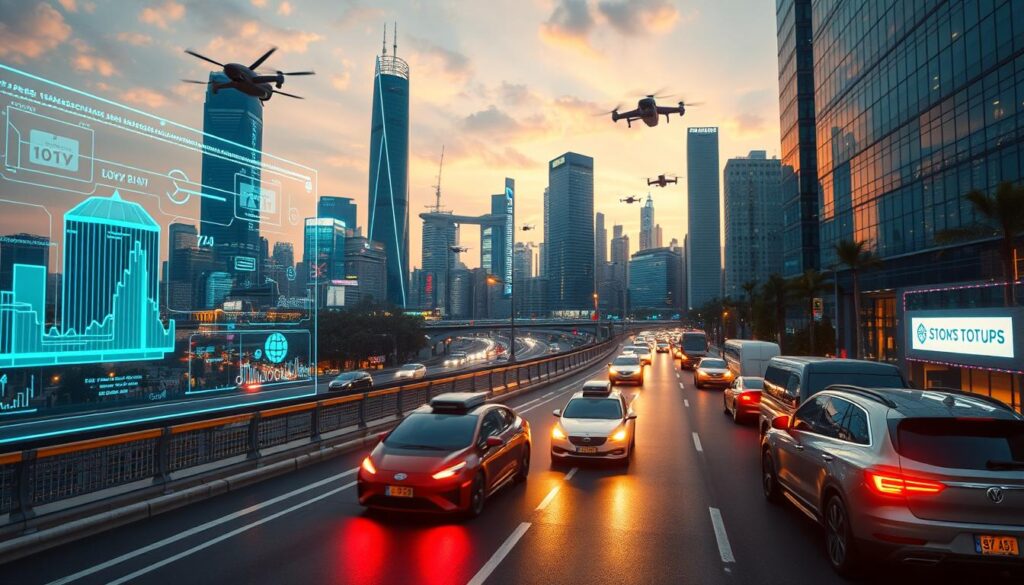
The landscape of transportation is being reshaped by groundbreaking innovations. These advancements are not only improving efficiency but also addressing challenges like congestion and cost management. From autonomous vehicles to smart traffic systems, the future of mobility is becoming more connected and sustainable28.
Autonomous Vehicles and Smart Traffic Management
Autonomous vehicles are at the forefront of this transformation. These vehicles use real-time data to navigate, reducing accidents and improving performance. For example, predictive maintenance minimizes downtime by analyzing vehicle conditions continuously28.
Smart traffic management systems are also playing a crucial role. By adjusting signals based on live traffic conditions, these systems reduce congestion and improve flow. This not only saves time but also lowers emissions, contributing to a greener environment29.
Collaborative Multiagent Systems and Innovation
Collaborative multiagent systems are another key trend. These systems allow different technologies to work together seamlessly. For instance, they optimize routes and manage demand dynamically, ensuring smoother operations28.
Companies like Amazon are already testing drone delivery services, showcasing the potential of these innovations. Such advancements are expected to expand to more locations by 2024, further enhancing customer satisfaction29.
These trends are reshaping the industry, offering new insights into how businesses can improve their supply chain. For more details on these transformative technologies, explore 10 AI Trends Transforming the Transportation Industry in.
Case Studies and Success Stories in AI-Driven Logistics
Companies across industries are achieving remarkable success by integrating advanced systems into their operations. These innovations are transforming the supply chain, delivering measurable improvements in efficiency and cost reduction. Real-world examples from industry leaders highlight the tangible benefits of these solutions.
Real-World Implementation Examples
Amazon has leveraged predictive analytics to optimize its inventory management, reducing stockouts by 30% and excess inventory by 25%30. This approach ensures smoother operations and better customer satisfaction. By automating processes, the company has also improved order fulfillment speed by 15%30.
FedEx has implemented advanced systems for route optimization, reducing fuel costs by 20% and increasing on-time deliveries by 35%30. These innovations have enhanced driver productivity by 40%, showcasing the potential of data-driven solutions30.
DHL has focused on integrating real-time data into its operations, achieving a 15% improvement in efficiency31. The company uses predictive maintenance to minimize downtime, ensuring cost-effective and reliable delivery services31.
Lessons Learned and Best Practices
These case studies demonstrate the importance of seamless integration and continuous improvement. Companies that invest in advanced technology can achieve significant cost savings and enhanced performance. The key is to prioritize data quality and adopt scalable solutions that meet evolving market demands.
By leveraging predictive analytics and real-time data, businesses can optimize their supply chain and improve customer satisfaction. The future of logistics lies in embracing innovation and addressing challenges with strategic decisions.
Steps for Transportation Companies to Get AI-Ready
Preparing for the future of transportation requires a strategic approach to technology and workforce readiness. Companies must focus on developing robust data infrastructures and fostering collaboration across departments. This ensures seamless integration of advanced solutions into existing systems.
Employee Training and Collaboration
Investing in employee training is crucial for successful technology adoption. Companies should provide comprehensive programs to upskill their workforce, ensuring they can effectively use new solutions. Cross-department collaboration also plays a key role in aligning goals and improving efficiency.
For example, businesses that prioritize workforce development report a 25% increase in operational performance32. This highlights the importance of preparing employees for the evolving demands of the industry.
Technological Readiness and Data Preparation
Building a strong data infrastructure is essential for leveraging advanced technologies. Companies must ensure their systems can handle real-time data processing and analysis. This enables better decision-making and improves overall management.
Predictive analytics can reduce costs by optimizing routes and minimizing delays33. By investing in these tools, businesses can enhance their supply chain and stay competitive in the market.
Early adopters of these technologies often achieve significant benefits, including improved customer satisfaction and streamlined operations. Companies like FedEx have seen a 15% increase in efficiency through data-driven solutions33.
In summary, preparing for the future involves a combination of workforce development and technological investment. By embracing these strategies, transportation companies can stay ahead of industry trends and achieve long-term success.
Conclusion
The integration of cutting-edge technology is reshaping how businesses manage their operations. From optimizing the supply chain to enhancing customer satisfaction, these advancements are driving significant improvements in efficiency and reducing costs34.
Real-world applications, such as route optimization and predictive maintenance, have proven the effectiveness of these systems. For example, companies using advanced solutions have reduced fuel consumption by up to 15% and improved delivery times by 25%35.
Despite the challenges of integrating new technology into existing systems, the benefits far outweigh the obstacles. Businesses that embrace these innovations are better positioned to meet future demands and stay competitive in a rapidly evolving market36.
Looking ahead, the focus will be on sustainable solutions and further innovation. By adopting strategic steps, companies can ensure they are ready to leverage these advancements for long-term success.
FAQ
How does agentic technology improve supply chain management?
What role does real-time data play in transportation logistics?
Can predictive analytics reduce transportation costs?
How does intelligent decision-making benefit fleet management?
What are the safety benefits of using AI in transportation?
How can AI improve customer experience in logistics?
What challenges do companies face when integrating AI into transportation systems?
How does AI contribute to urban mobility solutions?
What emerging trends are shaping the future of AI in transportation?
What steps should transportation companies take to prepare for AI adoption?
Source Links
- AI Agents Revolutionizing Logistics Optimization in 2025
- Harnessing AI Agents: Revolutionizing Supply Chain and Logistics
- AI’s Role in Logistics & Transportation: Revolutionizing Efficiency and Automation (With Examples)
- AI Revolutionizing Transportation & Logistics
- AI Revolution: How Artificial Intelligence is Transforming Logistics and Shipping – Odyssey Logistics
- AI Agents in Real-Time Logistics Management – TheCodeWork
- 6 Use Cases of AI in Transportation and Logistics: [2025 Edition]
- Bringing Droids into Business processes and Enterprise Systems
- 9 Agentic AI Examples: Real-World Use Cases and Applications
- AI agents in logistics and supply chain: Applications, benefits and implementation
- How artificial intelligence is transforming logistics | MIT Sloan
- Transforming Logistics with AI: Boost Efficiency and Cut Costs
- Revolutionizing Logistics: Unleashing Efficiency and Cost Reductions with AI Advancements
- Bringing Droids into Business processes and Enterprise Systems
- AI-Powered Real-time Shipment Tracking 2025 | Logistics Intelligence
- AI Agents Revolutionize Delivery Scheduling in 2024
- AI in Transportation: Advancing Mobility for Tomorrow
- Bringing Droids into Business processes and Enterprise Systems
- How AI Is Reshaping Transportation and Logistics (and Why It’s Good)
- How AI Agents in Transportation Are Changing the Roads
- Bringing Droids into Business processes and Enterprise Systems
- AI’s Role in Transforming Sales Processes in the Hospitality Industry
- Transforming urban mobility with artificial intelligence
- AI-Driven Optimization of Urban Logistics in Smart Cities: Integrating Autonomous Vehicles and IoT for Efficient Delivery Systems
- Open AI in Transportation 2023: Technologies, Startups, and Trends | Traction Technology
- Integrating AI into Your Logistics Operations: A Step-by-Step Guide
- Bringing Droids into Business processes and Enterprise Systems
- The Future Of AI In Logistics: 4 Trends to Watch
- Revolutionizing AI Agents in Logistics for the Future of Supply Chains
- Case Studies: How AI is Revolutionizing Logistics Firms | FreightAmigo
- AI in Logistics: Benefits, Challenges, Case Studies & Best Practices
- Artificial Intelligence in the Workforce: Strategies to Address in 2025
- Bringing Droids into Business processes and Enterprise Systems
- AI in Transportation Industry: Use Cases, Benefits, Challenges and Solutions
- AI in logistics and supply chain: Use cases, applications, solution and implementation
- AI in Logistics: Benefits, Use Cases, and Challenges







